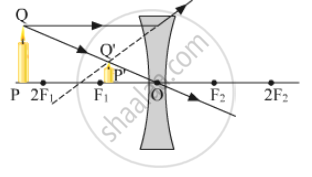Advertisements
Advertisements
प्रश्न
If the image formed by a lens for all positions of an object placed in front of it is always erect and diminished, what is the nature of this lens? Draw a ray diagram to justify your answer.
उत्तर
The type of the lens is concave lens.
Ray diagram is shown below:

APPEARS IN
संबंधित प्रश्न
Due to gradual weakening of ciliary muscles and diminishing flexibility of the eye lens a certain defect of vision arises. Write the name of this defect. Name the type of lens required by such persons to improve the vision. Explain the structure and function of such a lens.
If the numerical value of the power of this lens is 10 D, what is its focal length in the Cartesian system ?
Which type of lenses are:
thinner in the middle than at the edges?
When an object is placed 10 cm in front of lens A, the image is real, inverted, magnified and formed at a great distance. When the same object is placed 10 cm in front of lens B, the image formed is real, inverted and same size as the object.
What is the nature of lens B?
An object 60 cm from a lens gives a virtual image at a distance of 20 cm in front of the lens. What is the focal length of the lens? Is the lens converging or diverging? Give reasons for your answer.
Out of the two lenses, one concave and the other convex, state which one will show the divergent action on a light beam. Draw diagrams to illustrate your answer.
A concave lens, if kept at a proper distance from an object, can form its real image.
A virtual diminished image is formed when an object is placed between the optical centre and the principal focus of a lens.
(i) Name the type of lens which forms the above image.
(ii) Draw a ray diagram to show the formation of the image with the above stated characteristics.
Distinguish between concave and convex lens.
Choose the correct alternative and rewrite the following:
Inside water, an air bubble behaves ....................
